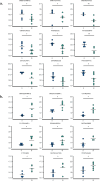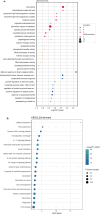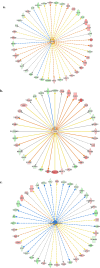Cross-sectional study of proteomic differences between moderate and severe psoriasis
- PMID: 39870771
- PMCID: PMC11772871
- DOI: 10.1038/s41598-025-87252-9
Cross-sectional study of proteomic differences between moderate and severe psoriasis
Abstract
Although an ongoing understanding of psoriasis vulgaris (PV) pathogenesis, little is known about the proteomic differences between moderate and severe psoriasis. In this cross-sectional study, we evaluated the proteomic differences between moderate and severe psoriasis using data-independent acquisition mass spectrometry (DIA-MS). 173 differentially expressed proteins (DEPs) were significantly differentially expressed between the two groups. Among them, 85 proteins were upregulated, while 88 were downregulated (FC ≥ ± 1.5, P < 0.05). Eighteen DEPs were mainly enriched in the IL - 17 signalling pathway, Neutrophil extracellular trap formation, Neutrophil degranulation and NF - kappa B signalling pathway, which were associated with psoriasis pathogenesis. Ingenuity pathway Analysis (IPA) identified TNF and TDP53 as the top upstream up-regulators, while Lipopolysaccharide and YAP1 were the top potential down-regulators. The main active pathways were antimicrobial peptides and PTEN signalling, while the inhibitory pathways were the neutrophil extracellular trap pathway, neutrophil degranulation, and IL-8 signalling. 4D-parallel reaction monitoring (4D-PRM) suggested that KRT6A were downregulated in severe psoriasis. Our data identify Eighteen DEPs as biomarkers of disease severity, and are associated with IL - 17 signalling pathway, Neutrophil extracellular trap formation, NF - kappa B signalling pathway, and defence response to the bacterium. Targeting these molecules and measures to manage infection may improve psoriasis's severity and therapeutic efficacy.
Keywords: 4D-parallel reaction monitoring; Biomarker; Data-independent acquisition mass spectrometry; Ingenuity pathway analysis; Proteomics; Psoriasis vulgaris.
© 2025. The Author(s).
Conflict of interest statement
Declarations. Competing interests: The authors declare no competing interests.
Figures






Similar articles
-
Systemic pharmacological treatments for chronic plaque psoriasis: a network meta-analysis.Cochrane Database Syst Rev. 2021 Apr 19;4(4):CD011535. doi: 10.1002/14651858.CD011535.pub4. Cochrane Database Syst Rev. 2021. Update in: Cochrane Database Syst Rev. 2022 May 23;5:CD011535. doi: 10.1002/14651858.CD011535.pub5. PMID: 33871055 Free PMC article. Updated.
-
Systemic pharmacological treatments for chronic plaque psoriasis: a network meta-analysis.Cochrane Database Syst Rev. 2017 Dec 22;12(12):CD011535. doi: 10.1002/14651858.CD011535.pub2. Cochrane Database Syst Rev. 2017. Update in: Cochrane Database Syst Rev. 2020 Jan 9;1:CD011535. doi: 10.1002/14651858.CD011535.pub3. PMID: 29271481 Free PMC article. Updated.
-
Association of Obesity and Innate Immune Markers With Resistance to Biologic Therapy in Psoriasis.JAMA Dermatol. 2025 Jun 1;161(6):629-634. doi: 10.1001/jamadermatol.2025.0288. JAMA Dermatol. 2025. PMID: 40172874
-
Cumulative methotrexate dose is not associated with liver fibrosis in patients with a history of moderate-to-severe psoriasis.Br J Dermatol. 2024 Jul 16;191(2):275-283. doi: 10.1093/bjd/ljae069. Br J Dermatol. 2024. PMID: 38366967
-
DIA proteomic and PRM validation through human granulose cells profiles screen suitable biomarkers for polycystic ovary syndrome patients.J Proteomics. 2024 Oct 30;309:105332. doi: 10.1016/j.jprot.2024.105332. Epub 2024 Oct 17. J Proteomics. 2024. PMID: 39424224
References
-
- Kimball, A. B. et al. Risks of developing psychiatric disorders in pediatric patients with psoriasis. J. Am. Acad. Dermatol. 67, 651–657.e651-652, (2012). 10.1016/j.jaad.2011.11.948 - PubMed
-
- Van den Bosch, F. & Coates, L. Clinical management of psoriatic arthritis. Lancet391, 2285–2294. 10.1016/s0140-6736(18)30949-8 (2018). - PubMed
-
- Griffiths, C. E. M., Armstrong, A. W., Gudjonsson, J. E. & Barker J. Psoriasis Lancet397, 1301–1315, doi:10.1016/s0140-6736(20)32549-6 (2021). - PubMed
-
- Sutaria, N. & Au, S. C. Failure rates and survival times of systemic and biologic therapies in treating psoriasis: A retrospective study. J. Dermatolog Treat.32, 617–620. 10.1080/09546634.2019.1688756 (2021). - PubMed
MeSH terms
Substances
LinkOut - more resources
Full Text Sources
Medical
Research Materials
Miscellaneous

